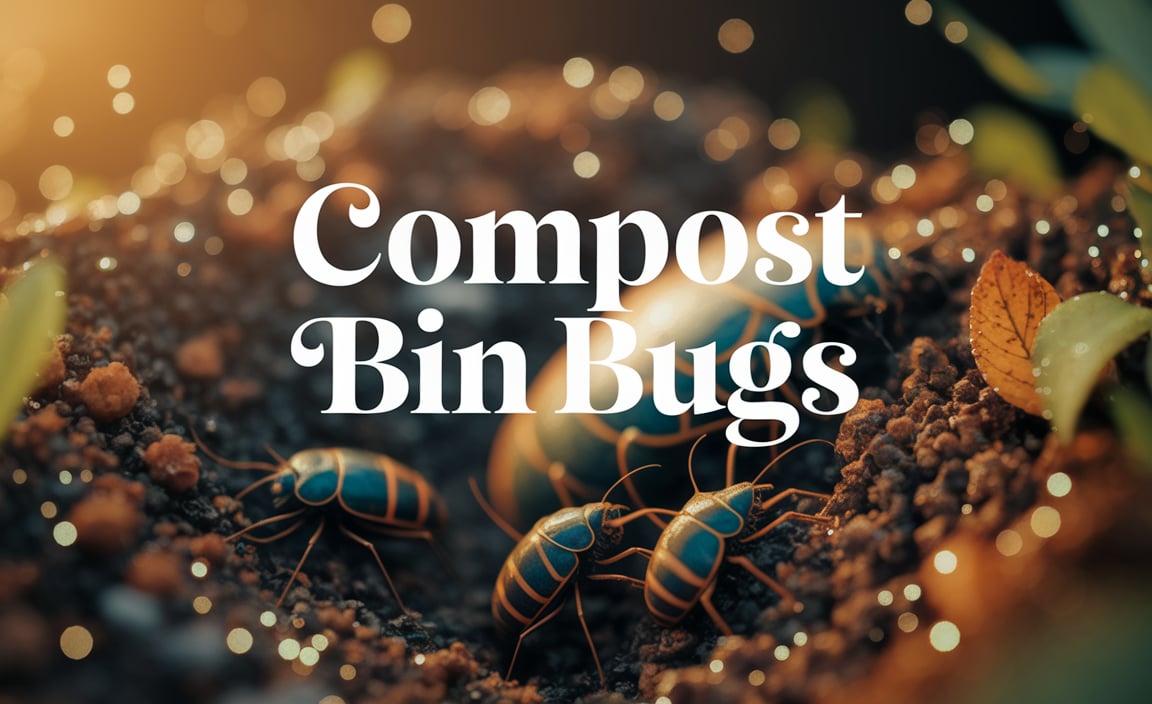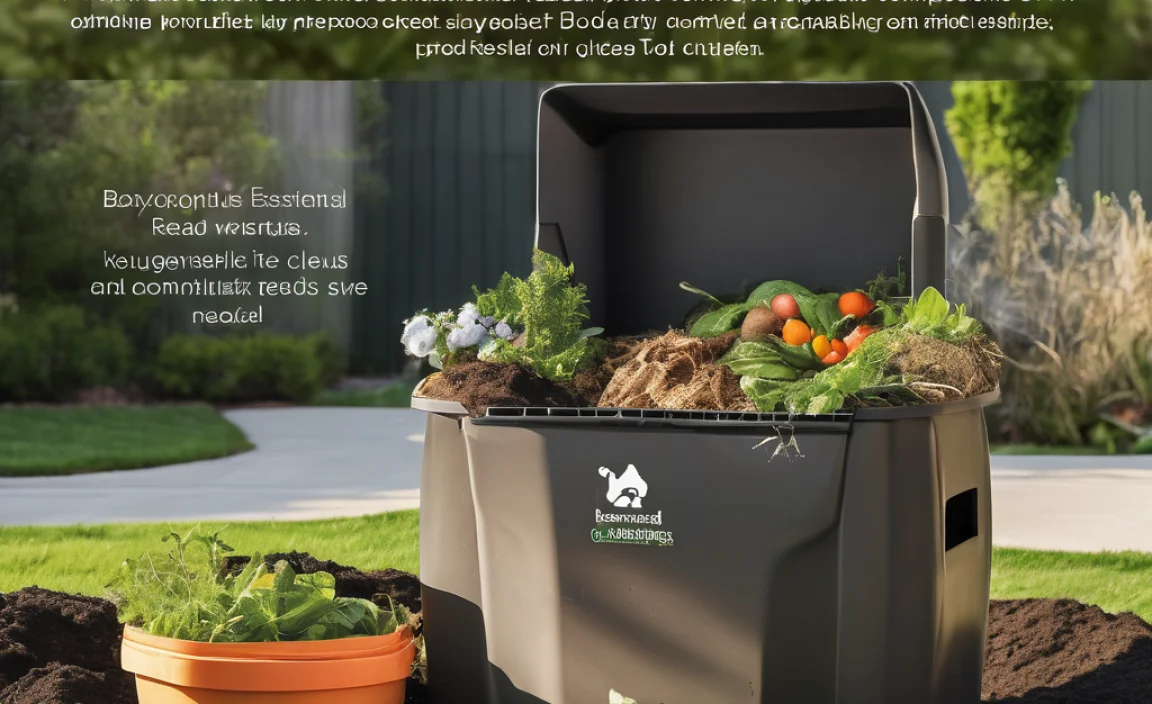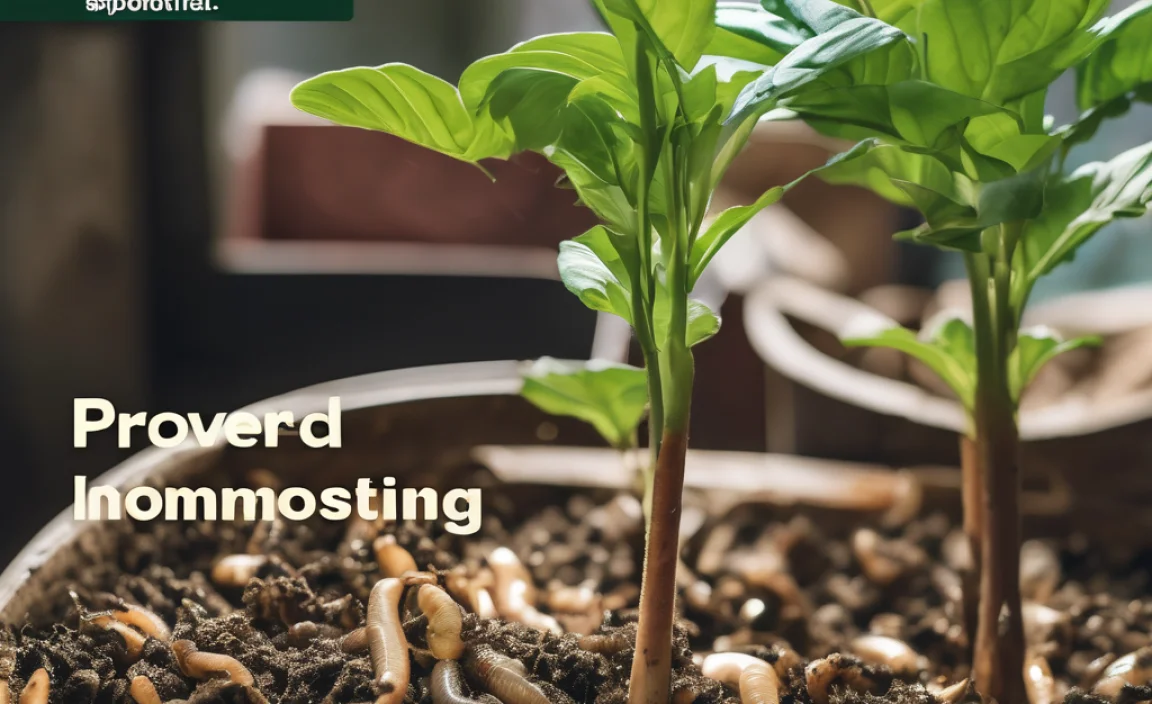Hey there, fellow home improvers and garden lovers! Troy D Harn here from TopChooser. Ever peeked into your compost bin and seen more crawling critters than you expected? It’s a common sight, and honestly, a little unsettling at first. But don’t worry, those little guys often mean your compost is working! We’re going to break down the most common compost bin bugs, figure out if they’re friends or foes, and show you how to keep your compost pile healthy and balanced. It’s simpler than you think!

Your Friendly Guide to Compost Bin Bugs
Composting is a fantastic way to reduce waste and create incredible food for your garden. But sometimes, the inhabitants of your compost bin can make you do a double-take. Are they pests? Are they helpers? The truth is, most of the bugs you’ll find in a healthy compost bin are actually beneficial! They’re nature’s tiny cleanup crew, breaking down your scraps into rich, dark compost. However, a few unwelcome guests can pop up if things get out of balance. This guide is all about identifying those common compost bin inhabitants, understanding their role, and knowing when to take action.
Why You Might See Bugs in Your Compost Bin
Think of your compost bin as a bustling micro-ecosystem. When you toss in food scraps and yard waste, you’re providing a buffet for a whole host of organisms. These include beneficial insects, bacteria, fungi, and yes, even some larger critters. Their presence is usually a sign that the composting process is underway. The key is to differentiate between the helpful residents and those that might indicate a problem.
Several factors influence what kind of bugs show up:
- Moisture Levels: Too wet or too dry can attract different types of critters.
- Temperature: The heat generated by decomposition (or lack thereof) plays a role.
- Type of Materials: What you’re composting — lots of greens, lots of browns, or maybe something they shouldn’t be eating.
- Bin Type: Open piles vs. enclosed bins can attract different wildlife.
The Good Guys: Beneficial Compost Bin Bugs
Let’s start with the residents you actually want! These are the hard workers that speed up decomposition and turn your waste into black gold for your garden. They’re often mistaken for pests, but they are your composting allies.
Compost Sifters (Springtails & Mites]
If you see tiny, pale, or gray bugs that jump when disturbed, you’re likely looking at springtails. Mites might appear as tiny red or brown specks. These micro-arthropods are incredibly important for breaking down tougher materials like leaves and plant matter. They thrive in moist, dark conditions and are a sign of a healthy, active compost pile.
The Decomposer Crew (Beetles & Larvae]
Various beetles and their larvae are common. Soldier fly larvae, for instance, are voracious eaters and excellent composters. Rove beetles and ground beetles also play a role in breaking down materials and can help control other, less desirable pests like fly eggs. Don’t be alarmed by their segmented bodies or hard shells; they’re working hard.
The Earthworm Army (Earthworms]
These are the superstars of composting! Red wigglers are particularly popular for vermicomposting (worm composting), but common garden earthworms will also find their way into a well-maintained compost bin. They’re excellent at aerating the pile and converting organic matter into nutrient-rich castings. Their presence is always a good sign.
The Tiny Cleaners (Fungus Gnats & Their Larvae]
You might notice small, dark flies, similar to fruit flies, hovering around your compost bin. These are likely fungus gnats. While their adult form can be a bit annoying, their larvae are beneficial. They feed on fungi and decaying organic matter. If you have a lot of them, it might mean your bin is a bit too wet or has too many “green” materials (like fruit and vegetable scraps).
When Bugs Signal Trouble: The Unwelcome Guests
While most bugs are good, a sudden surge in certain types, or the appearance of specific critters, can signal that your compost bin’s ecosystem is out of balance. This is often due to issues like excessive moisture, lack of aeration, or the presence of materials you shouldn’t be composting.
The Obvious Pests (Ants & Flies]
Ants: A few ants might explore your compost bin, especially if it’s on the drier side. However, a large ant colony indicates a problem. Ant nests in compost bins often mean the bin is too dry, or there’s readily available food without enough moisture to deter them. They can sometimes break down materials but out of control, they can make it hard for beneficial microbes and worms to work.
Flies (House Flies, Fruit Flies): While fungus gnats are usually harmless, a massive influx of house flies or fruit flies can be a sign of trouble. This typically occurs when fresh food scraps are exposed on the surface of the compost pile and aren’t buried properly. This is particularly common in open-air compost bins and can attract unwanted attention and odors.
Signs of a Stagnant Pile (Maggots, Slugs, Snails]
MaggOTS: A small number of fly maggots are a natural part of the decomposition process, especially with fresh food scraps. However, if you see large clusters of them, it usually means your compost is too wet and not heating up properly. This can lead to unpleasant odors and attract more flies. They are a sign that the pile needs aeration and balancing.
SLugs & Snails: These slimy visitors prefer moist, dark environments. While they do contribute to decomposition, large populations can indicate that your compost bin is too wet and lacks sufficient “brown” materials (like dried leaves or cardboard) to absorb excess moisture. They can also eat and damage new seedlings if you’re using your compost nearby.
Understanding the Role of Common Compost Bin Bugs
It’s helpful to understand what each type of bug is actually doing in your compost. This helps you decide if they’re a problem or just part of the process.
| Bug Type | Primary Role | When It’s a Problem | Signs of Abundance |
|---|---|---|---|
| Springtails | Break down tough organic matter (leaves, wood). | Rarely. | Jumping when disturbed. |
| Mites | Decompose small particles and fungi. | Rarely. | Tiny specks, often red. |
| Beetles & Larvae | Consume waste, aerate, prey on other pests. | Large predatory beetles can eat worms if populations are unbalanced. | Visible in soil and decomposing material. |
| Earthworms | Consume waste, aerate soil, produce castings. | None. | Visible moving through the pile. |
| Fungus Gnats (Larvae) | Break down fungi and decaying matter. | Large presence may mean too wet/green. | Small dark flies hovering; larvae in moist material. |
| Ants | Disperse materials, break down dry matter. | Large colonies can dominate, creating dry pockets, stressing worms. | Nest-building, extensive trails. |
| Flies (House/Fruit) | Consume exposed food scraps. | Indicates exposed food, potential odor issues, can spread pathogens if not contained. | Swarming around the bin, especially on exposed kitchen scraps. |
| Maggots | Rapidly break down fresh food waste. | Indicates a too-wet, non-heating pile; potential odor. | Large numbers on fresh food scraps. |
| Slugs & Snails | Consume decaying vegetation. | Indicates a very wet pile, can damage seedlings. | Slime trails, visible on moist surfaces. |
Tips for Keeping Your Compost Bin’s Bug Population Balanced
The goal isn’t to eliminate all bugs, but to encourage the beneficial ones and discourage the problematic ones. This usually comes down to a few key composting practices.
1. Proper Composting Techniques: The Foundation of Balance
The best way to manage compost bin bugs is to maintain a healthy compost process. This means getting your “greens” and “browns” ratio right, maintaining the correct moisture level, and ensuring adequate aeration.
The Green-to-Brown Ratio:
- Greens (Nitrogen-rich): Fruit and vegetable scraps, grass clippings, coffee grounds, tea bags. These provide moisture and nitrogen, fueling the microbes.
- Browns (Carbon-rich): Dried leaves, shredded cardboard, newspaper, straw, sawdust. These provide carbon, add bulk, and help with air circulation and moisture absorption.
A good starting point is a 2:1 or 3:1 ratio of browns to greens by volume. Too many greens can lead to a wet, slimy, smelly pile that attracts flies and maggots. Too many browns can slow down decomposition.
Moisture Control:
Your compost pile should feel like a damp, wrung-out sponge. Not dripping wet, and not bone dry. If it’s too wet, add more browns and turn the pile to aerate it. If it’s too dry, add some water and mix it in. Covering your compost bin during heavy rains can also help prevent it from becoming waterlogged.
Aeration:
Composting organisms need oxygen. Turning your compost pile regularly (every 1-4 weeks, depending on the speed you want) introduces air, mixes materials, and helps regulate temperature. This is crucial for preventing anaerobic conditions, which can lead to foul odors and attract less desirable decomposers.
2. Burying Food Scraps
This is especially important if you’re dealing with fruit flies or attracting larger animals. Always bury fresh kitchen scraps deep within the compost pile, under a layer of browns. This hides the scent and makes it less accessible to pests and flies.
3. Adding the Right Materials
Avoid composting things that are likely to cause problems. This includes:
- Meat, dairy, and oily foods (tend to attract pests and create odors)
- Diseased plants (can spread disease back into your garden)
- Weeds that have gone to seed (can spread weeds)
- Pet waste (from cats or dogs, can contain pathogens)
Sticking to yard waste and approved kitchen scraps will keep your bin healthier.
4. Choosing the Right Compost Bin
The type of bin you use can influence the types of bugs you attract. Enclosed plastic bins can deter larger animals and help retain heat, which can be good for beneficial microbes but might make it harder for some larger bugs to get in and out. Open-air bins are more accessible to a wider range of organisms, including beneficial predators like ground beetles, but can also attract more unwanted visitors from the wider environment.
For managing pests, consider a bin with a secure lid. The EPA provides excellent resources on composting, including advice on bin types.
Addressing Common Compost Bin Bug Issues
Let’s tackle some specific bug problems and how to solve them.
Problem: Too Many Ants
Cause: The pile is likely too dry, or there is a high concentration of sugary materials attracting them.
Solution:
- Moisten the pile: Water the compost thoroughly and mix it in.
- Add more greens: A surge in food scraps can sometimes attract them.
- Bury food scraps: Make sure they are well-covered with browns.
- Introduce worms: Earthworms can help aerate the pile and outcompete ants for resources.
Problem: Swarms of Flies and Maggots
Cause: Exposed food scraps, especially meat or dairy (which you should avoid composting), or a pile that is too wet and not heating up.
Solution:
- Bury food scraps: Ensure all kitchen waste is covered with at least 6-8 inches of compost material or browns.
- Add more browns: Shredded cardboard, dried leaves, or straw will absorb excess moisture and balance the pile.
- Turn the pile: Aerate the compost to encourage heating and break up maggot clusters.
- Consider a screened lid: For enclosed bins, a fine mesh lid can help prevent flies from entering.
Problem: Slugs and Snails
Cause: The compost pile is consistently very wet and lacks sufficient aeration.
Solution:
- Add browns: Increase the amount of carbon-rich materials to absorb excess moisture.
- Aerate the pile: Turn the compost regularly to improve air circulation and dry it out slightly.
- Check bin drainage: Ensure your compost bin has adequate drainage holes.
- Manual removal: If they persist, you can manually remove them, especially from the perimeter.
Natural Ways to Manage Unwanted Compost Critters
Before reaching for any kind of treatment, remember that nature often finds its own balance. However, sometimes a little nudge is needed.
- Encourage Predators: Birds, frogs, and larger beneficial insects like ground beetles can help control populations of smaller, less desirable bugs like slugs and flies. A healthy garden surrounding your compost bin will attract these helpful predators.
- Diatomaceous Earth (Food Grade): In extreme cases, a light dusting of food-grade diatomaceous earth around outdoor compost bins (avoiding the inside where beneficials live) can help dehydrate and kill crawling insects like ants. Use sparingly and with caution, as it can harm beneficials too. Ensure it’s the food-grade, non-toxic variety.
- Maintain Aeration: Simply turning your compost pile well and often is one of the most effective “natural pest controls” there is. It disrupts habitats and promotes a healthier environment for beneficials.
Frequently Asked Questions About Compost Bin Bugs
Q1: Are all bugs in my compost bin bad?
No, not at all! Most bugs, like springtails, mites, and especially earthworms, are beneficial. They are the hard workers breaking down your organic waste. Seeing a variety of these helps ensure your compost is healthy and active.
Q2: I see maggots. Is my compost ruined?
Not necessarily! Maggots are common, especially on fresh food scraps, and are very efficient decomposers. A few are normal. However, if you see large masses of them, it usually means the pile is too wet and isn’t heating up properly. Bury the scraps deeper and add more “brown” materials like leaves or cardboard to balance it.
Q3: How can I stop fruit flies from bothering my compost bin?
The best way is to always bury your kitchen scraps deep inside the compost pile, under a layer of browns (like dried leaves or shredded paper). This hides the scent and makes them less accessible. If it’s a persistent problem, consider a compost bin with a more secure lid.
Q4: My compost bin has a lot of ants. What’s wrong?
Ants are usually a sign that your compost pile is too dry. They like dry conditions. Try watering the pile thoroughly and mixing it in. Adding a few more “green” materials might also help keep it moist enough to deter them.
Q5: Should I worry about spiders in my compost bin?
Spiders are generally beneficial! They are predators and will help control populations of other insects, including some that might be considered pests. As long as they aren’t negatively impacting your composting process or your comfort level, it’s best to leave them be. They can be a great natural pest control.
Q6: Are slugs and snails bad for my compost?
Slugs and snails do contribute to decomposition, but a large population usually indicates that your compost bin is too wet and might not be aerated well. They can also sometimes munch on delicate new plants if your compost is close to your

I am passionate about home engineering. I specialize in designing, installing, and maintaining heating, ventilation, and air conditioning systems. My goal is to help people stay comfortable in their homes all year long.


